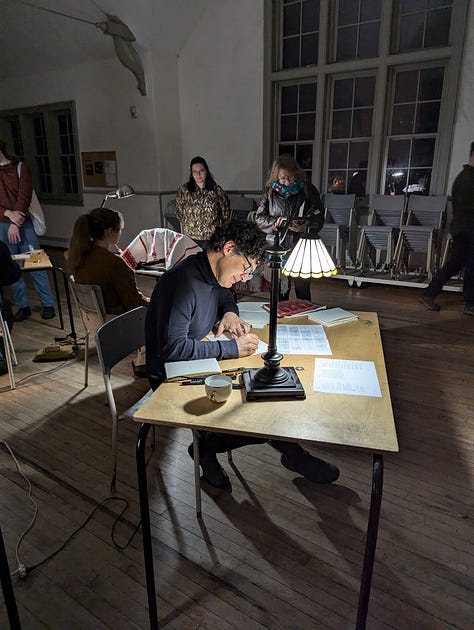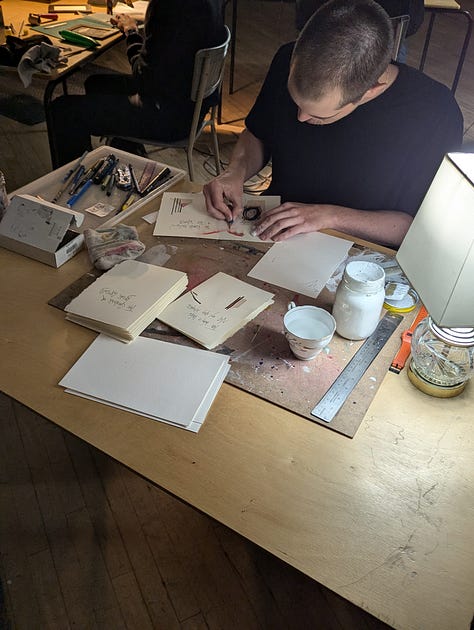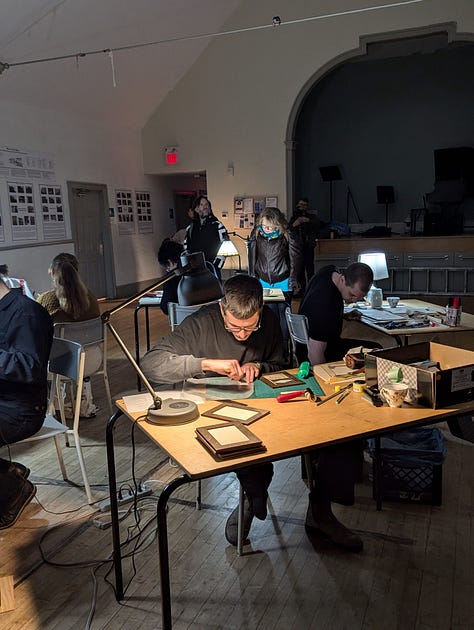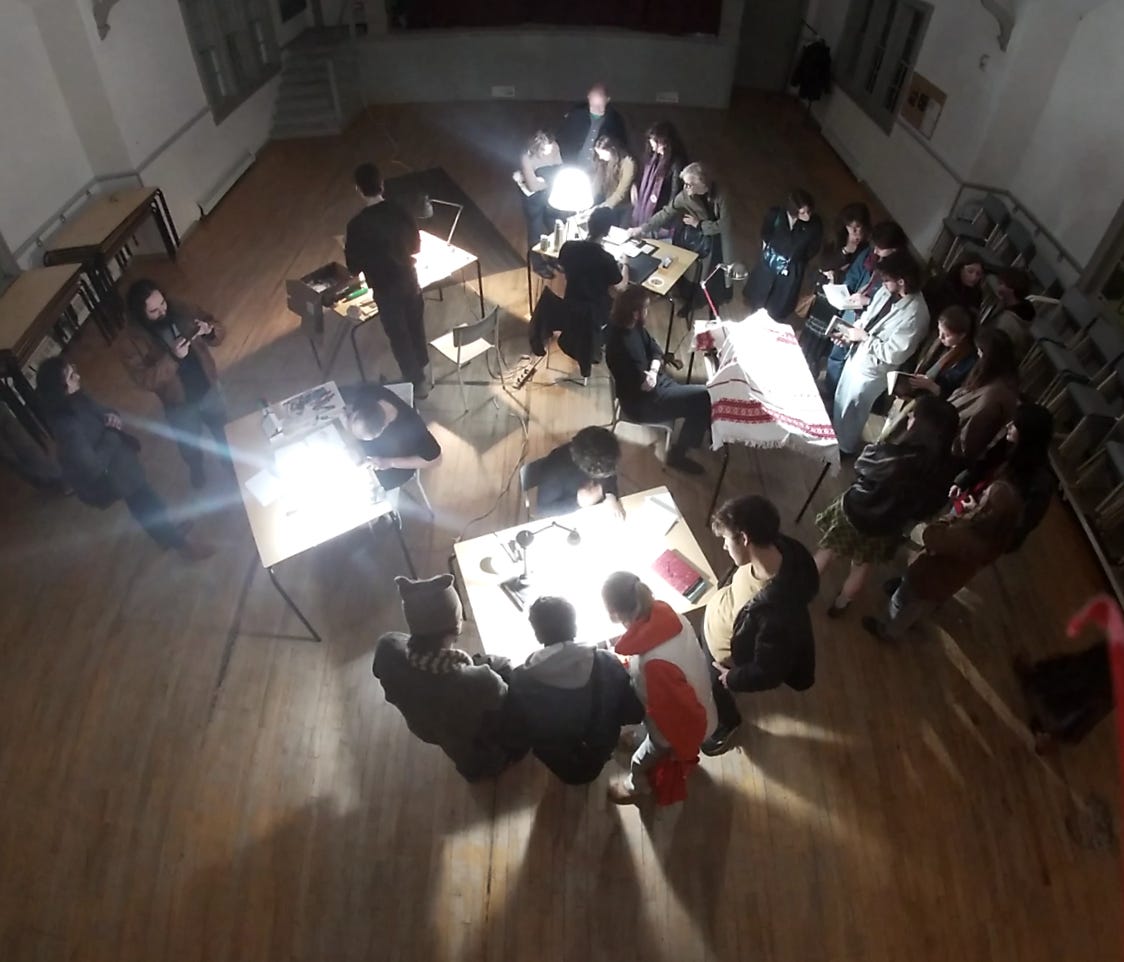Microcosms: The World and the Work of Art
A reflection on our project, "Bound", and its six handmade books of illustrated poetry
On Saturday, October 19, myself and three other local artists performed a project I directed called Bound. For six hours we made books by hand, live. Each of the six volumes features a single poem by Christopher Snook, visual art and illuminations by Henry Lachance, collages on the front and back covers by Gregor Chiasson, and a Coptic book bind by myself.
We had been preparing this project for months and didn’t know what to expect from the performance. Would people come? Would it feel uncomfortable? Would we run out of work to do? Would we be able to finish any of the books?
In the end, we were completely blown away by the generosity of all 200+ of you who visited our exhibit. We were staggered by the openness with which guests engaged in the performance and were overwhelmed by the feelings of focus and attention you brought into the creative process. Being with you there was an experience that invigorated and enriched the work. In new ways it taught us about what art is and means. It was such a beautiful night of collaboration and presence, and it completely exceeded my expectations.



A very warm welcome to all of you who signed up for the newsletter at the performance. It’s great to have you here. I hope you’ll hang around for a while and even take a look at the newsletter’s archive which includes, among other things, a series on the strangely analogous spiritualities of mountaineering and the writing life.
For those of you who missed the exhibit, at the bottom of this post you will find a playlist of original music that was the soundtrack for the performance, and a read-along video tour of all six of our handmade books.
We spent so much of the night totally absorbed by our respective tasks, and we would very much like to know: What was the performance like from your perspective? Please like, share, and leave a comment on this post to let us know!
Microcosms
“Microcosms” was this year’s theme at Nocturne, the art festival that hosted our project, and it was at the heart of our project and its intention. While preparing for the exhibit, we talked a lot about this totally pervasive myth: that art is most authentic when it stands as an act of solitary genius in opposition to the world. I’m not thinking here of the crucial ways that art and resistance can work together. I’m talking about something dangerous that threatens to tear us both from our place in the world and from communion with one another.
With this concern in mind, we designed Bound according to the following considerations:
There were to be six books (a gesture towards the late-ancient and medieval hexameral tradition of writing commentaries on the six days of creation in the book of Genesis).
Our workstations must be arranged in a circle—a microcosmic image of the world.
Further, as artists complete their work on each book, materials are to be passed clock-wise (that is, sun-wise) around the circle.
Finally, after visitors make a similar circumabulation, moving from table to table, their journey ends at a final station where they are invited to accomplish the most critical part of the work: reading the books.
It was the last of these three moments that I found so moving about this project. My desk, where I sat all evening sewing pages together, was to the immediate left of the final table. At times in the evening, visitors began piling up before my station. It took me a moment to realize that they were waiting for a turn to pick up the books for themselves. It was something, of course, that we had hoped people would do, but I didn’t anticipate how readily and with what purpose folks would perform this final task.
At that final table, the visitors passed beyond being a “passive audience” (which is also a myth). When each of you read them for yourselves, integrated into the same circle that traced the books’ coming into being, you brought the work of art to its perfection. And of course, the artwork that seems to “stand in opposition to the world” never really does. There is always reciprocity and exchange. But the books somehow made that clear to me in a new way. Perhaps it is because a book is more obviously something that must be used or engaged to become, finally, “what it is”. When someone is brave enough to pick up a book, to be shaped by its contents, and in turn to bring the shape of their understanding to what they read, there is present there a little cosmos—a microcosm.
The Music
There is so much I could say about the exhibit’s soundtrack, which I had been feverishly preparing up until the day before the event, but we will have to save most of that for some future occasion. I have some dreams of ways we might share this music, which I was so glad to hear from visitors was an integral part of the exhibit, in some sort of official way. For now, I’m happy to share a playlist of demos and works-in-progress. The tracks are mostly unmixed and unmastered, and in some cases are unfinished. Most were recorded at our home in Halifax and at the beautiful organ of St. George’s Round Church. About these songs, I trust that more will be revealed.
The Future of the Project
We now have a beautiful body of work (see the video above for my first real-time read through of the entire series). We are transitioning now to thinking about the future of the project: what is next for these six books of poetry? (A gallery show? A publication? A concert? A “Part 2”?)
If you have any ideas or suggestions for us, please share them here or send me an email.
Thank you all for being here and reading these missives. It would mean the world to me if you shared this newsletter with a friend or family member who you think might also enjoy being along for the ride.
—Matthew






